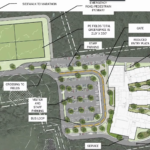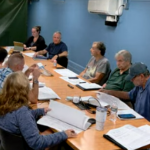At its meeting Monday night, the Zoning Advisory Committee continued its discussion on solar zoning and how it could formulate wording to limit developments in residential areas.
The discussion centered around language and specific requirements the committee might suggest be adopted as part of a commercial ground-mounted solar bylaw.
Among the items discussed was setbacks. The current bylaw calls for a 60-foot setback. Committee member Ted Barker-Hook noted that 60 feet is the width of 6 1/2 standard parking spaces, or the distance from the pitcher’s mound to home plate on a baseball field. Making the distance substantially farther often won’t make a major difference. Case in point: the solar array on Lumber Street, which is clearly visible from many homes on Alexander Road even though it is, Barker-Hook said, more than 300 feet from the nearest back door.
The problem with that array — an example oft cited as something the town wants to avoid letting happen again — is the topography. Committee chair Mary Larson-Marlowe explained that the land slopes downward from Alexander Road, then rises up to where the solar array is, which makes the setback and screening there almost useless.
“I don’t think the setback’s going to help us,” committee member Ria McNamara commented, adding: “That structure off Alexander is abominable. Who buys a residential house in a residential neighborhood expecting that to be plunked down behind them? Nobody. It’s unfortunate. We got caught unawares. We just need to fix it.”
McNamara suggested focusing on limiting the size of an array, primarily to make it less profitable.
“If it’s not economically feasible today it’s not going to happen,” she said. “The developers are not going to show up. We’re looking at another town here that says 1.5 acres [maximum size]. That’s what makes sense. Because that really literally reduces the ability to do a solar farm here again.”
McNamara said another advantage to capping the size is it’s a simpler plan, and one that would be an easier sell to voters who must approve any bylaw changes at Town Meeting.
“If we limit the amount of land for these things then we don’t see the thing happening,” she said. “That’s a fact. It’s financially unfeasible. And I think that that’s an easier, faster way of reducing the number of solar farms coming here than trying to go through screening and coverage and all these other things that we were talking about. Because yeah, the average person going to Town Meeting falls asleep. They don’t get these things. It’s not like this is part of their everyday vernacular. So I’m just saying if we were to pick something, that’s probably the easiest thing to pick, and explaining it as to why it’s not economically feasible. … I’m all for screening and I’m all for coverage, but that’s not going to work at Town Meeting.”
Committee member John Coutinho said any changes must be clear, specific and defensible, to minimize the risk of the town being sued.
“We have to be careful about saying what we want people to do with their land,” he said, noting the town has limitations regarding private property. Added Coutinho: “We have to be careful with the subjectivity. It just leaves too much open and it leaves us way open for lawsuits. To Ria’s point, if you want to do something, you’ve got to put it in writing, what the numbers are.”
The discussion will be continued at a future ZAC meeting. Larson-Marlowe encouraged members to take some time and come up with items to focus on going forward.
“Write down what you think is important that the Planning Board will have in front of them as the bylaw to hold developers to,” she said.






















0 Comments